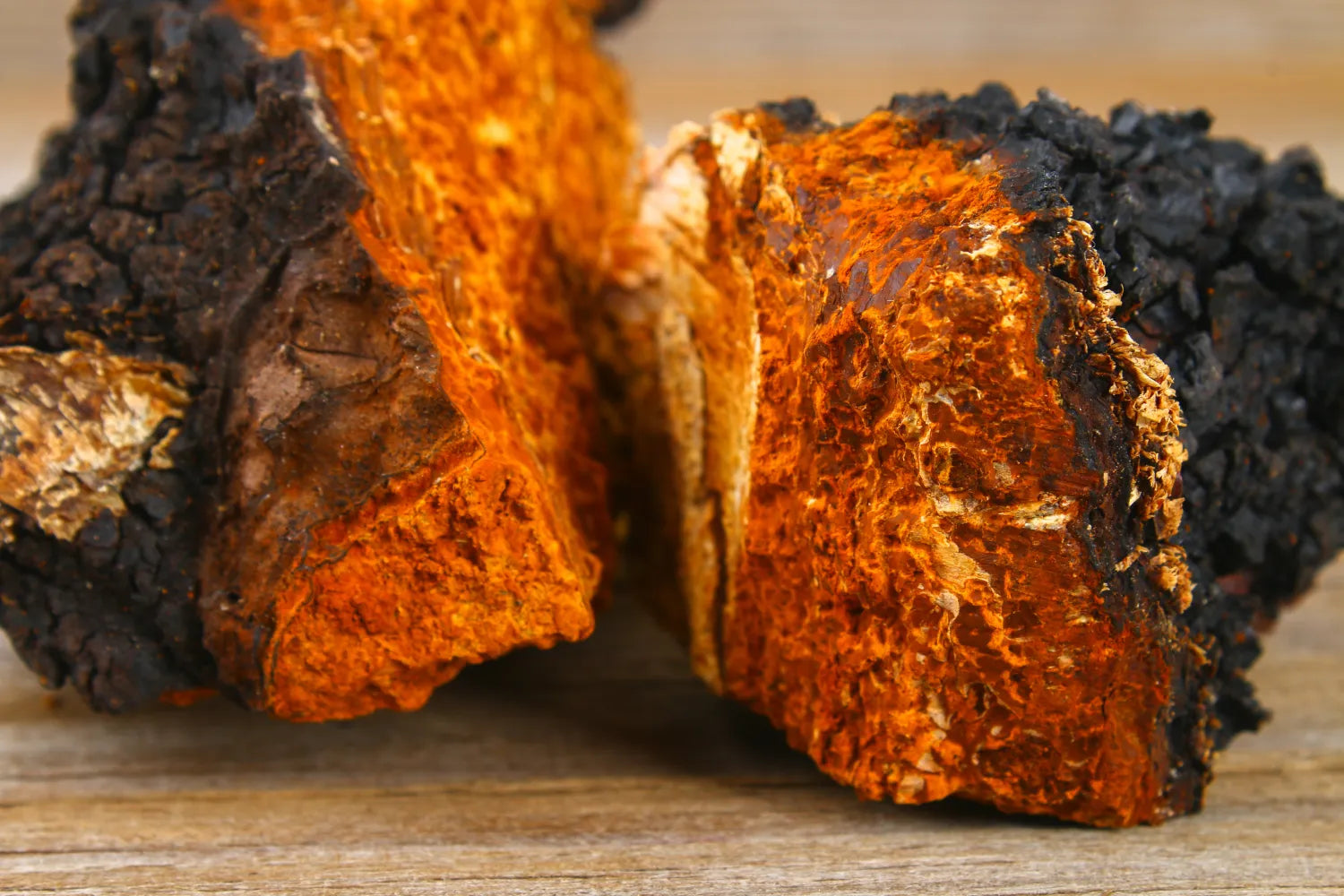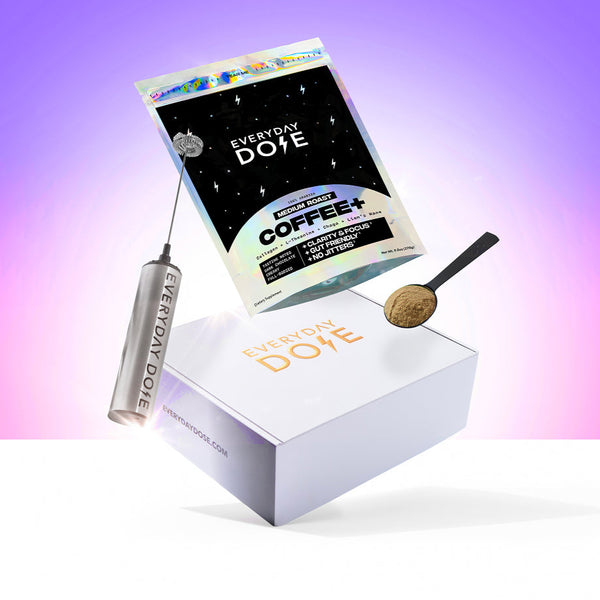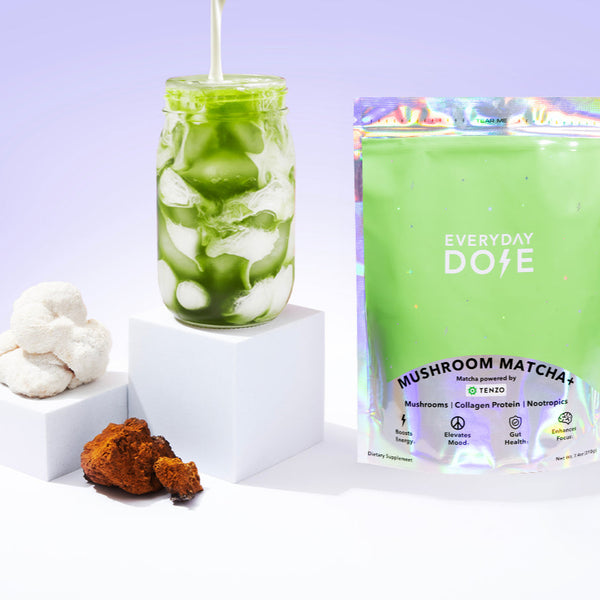The History and Origin of the Chaga Mushroom

You might know chaga as a bitter mushroom that looks like a lump of coal, but history shows us that there’s more to it than we might think. This mushroom has been used for centuries to support health, and modern research has shown us even more of its benefits.
No matter what supplements you take, it’s important to know where they come from and how they can affect your body. Read on to learn everything you need to know about the history of chaga, its benefits, and how to choose the best chaga supplement.
Where Does Chaga Grow?
Chaga (Inonotus obliquus) isn't your average mushroom. This funny-looking fungus thrives in cold climates, growing exclusively on birch trees in regions like Siberia, Northern Europe, Canada, and parts of the U.S.
Unlike the typical cap-and-stem mushrooms you might be familiar with, chaga forms a hardened mass called a sclerotium. Visually, it resembles a chunk of burnt charcoal on the outside while hiding a vibrant orange interior.
But don't let its rugged appearance fool you. Chaga is a parasitic fungus, drawing nutrients from its birch host, which contributes to its rich composition of bioactive compounds. This slow-growing ‘shroom can take years to mature, which makes sustainable harvesting practices more important than ever.
How Has Chaga Historically Been Used?
Chaga's medicinal use dates back centuries, with records from the 16th century highlighting its role in Russian and Siberian folk medicine. Indigenous Siberian tribes, like the Khanty, brewed chaga tea to address ailments ranging from tuberculosis to digestive issues.
Preparation methods were straightforward, yet effective. They mostly involved drying the chaga, grinding it into a fine powder, and brewing it into a tea. This traditional approach allowed communities to harness chaga's health benefits long before modern science caught up.
In Russia, Poland, and parts of Finland, chaga tea was also used as a coffee replacement. Known for its smooth, earthy flavor, it’s naturally caffeine-free but still offers a gentle pick-me-up for those who can get past its bitterness.
What’s in Chaga Mushrooms?
Chaga is rich in bioactive compounds like polysaccharides, triterpenoids, melanin, and polyphenols, all contributing to its antioxidant and immune-supporting effects. While specific nutritional data is limited, chaga is known to be low in calories, high in fiber, and packed with antioxidants.
These compounds work synergistically to combat oxidative stress, soothe irritation in the body, and support overall health. It's no wonder chaga has earned its superfood status in both traditional and modern wellness circles.
What Are the Health Benefits of Chaga Mushrooms?
Chaga has a longstanding tradition of medicinal use, but its benefits aren’t just based on stories. Recent research has confirmed many of the historical uses of chaga, showing us that this mushroom offers more than just an earthy flavor.
The benefits of chaga include the following:
- Immune System Support: Chaga extract may support white blood cells, encouraging the body's ability to fight off harmful bacteria and viruses.
- Antioxidant Properties: Rich in antioxidants, chaga can help minimize the harmful effects of oxidative stress, which can support long-term health.
- Blood Sugar Support: Chaga may encourage healthy blood sugar levels and insulin sensitivity.
- Cholesterol and Heart Health: Chaga has been found to support healthy levels of LDL cholesterol and triglycerides, supporting cardiovascular health.
What To Do if You See Chaga in the Forest
Chaga is a slow grower — think years, not months. Because of this, sustainable harvesting is key to keeping it in the ecosystem for generations to come.
Ethical foragers only remove a portion of the chaga from each birch tree, allowing it to regrow and continue its relationship with its host. Overharvesting not only kills the tree but also threatens wild chaga populations, especially as global demand rises.
Want to spot it in the wild? Look for a dense, black, crusty mass (kind of like burnt charcoal) jutting out from a white or yellow birch tree. Crack it open, and you’ll see a golden-orange interior.
Just remember: chaga is part of a living forest system, not a free-for-all snack bar. If you're not trained in ethical foraging, it’s better to support brands that follow sustainable wildcrafting practices.
How To Choose a Good Supplement
Not all chaga supplements are created equal. If you’re spending your hard-earned cash on a supplement, you want the good stuff. So what should you look for?
First, make sure it's double-extracted. That means the chaga has been processed using both hot water and alcohol extractions to pull out all the beneficial compounds, like polysaccharides and triterpenoids. One method alone won’t cut it if you're after the full wellness package.
Next, look for 100% fruiting bodies, not mycelium. Many cheap supplements sneak in lab-grown mycelium that’s packed with filler (and not much else). True chaga supplements are made from the wild-harvested, charcoal-crusted sclerotia we’ve been talking about.
Ideally, it should also be wood-grown or wild-harvested, because chaga mushrooms have more nutrients when they’re fed their natural diets. If the label doesn’t specify its growing medium, that’s your cue to move on.
Finally, transparency matters. The best brands will back up their products with third-party testing and sustainability practices, because good chaga shouldn’t come at the planet’s expense. For instance, all of our mushrooms are tested for beta-glucans, heavy metals, allergens, mycotoxins, and mold.
And, of course, all of our mushroom blends feature double-extracted, 100% wood-grown chaga fruiting bodies. And if that wasn’t enough, our Mushroom Coffee+ also contains L-theanine, lion’s mane mushroom, collagen, and coffee extract. It packs the benefits of chaga with the delicious taste of a good cup of joe.
The Bottom Line
From Siberian stews to supplement shelves, chaga has come a long way, and it’s easy to see why. With centuries of traditional use and a growing body of research, this mushroom is gaining some serious street cred.
But as with any trend, quality matters. If you're going to sip, sip smart. If you want a supplement that contains only the good stuff, check out our collection of mushroom blends today.
Sources:
Immunomodulatory Activity of the Water Extract from Medicinal Mushroom Inonotus obliquus | PMC
5 Reasons to Consider Chaga Mushrooms | American Association of Naturopathic Physicians
Start your day
The Right Way








